Discover 15 hidden attractions, cool sights, and unusual things to do in Santo Domingo (Dominican Republic). Don't miss out on these must-see attractions: Alcázar de Colón, Estadio Quisqueya, and Columbus Lighthouse. Also, be sure to include Basilica Cathedral of Santa María la Menor in your itinerary.
Below, you can find the list of the most amazing places you should visit in Santo Domingo (Distrito Nacional).
Table of Contents
Alcázar de Colón
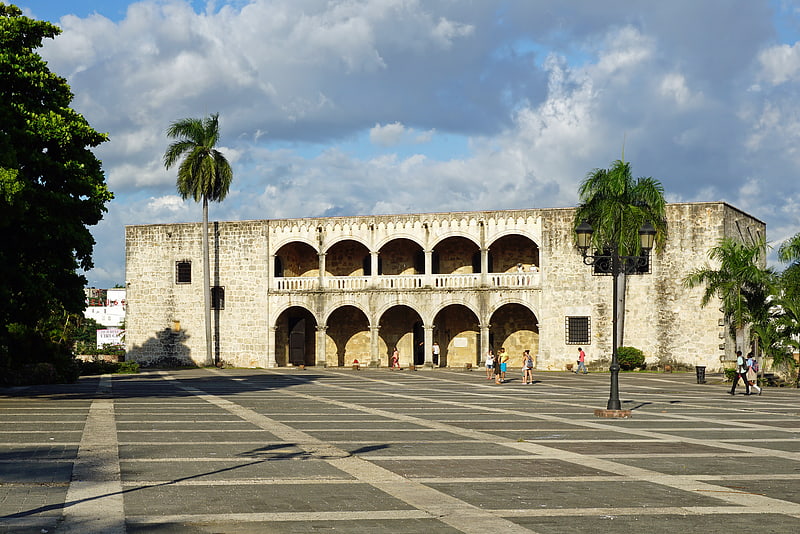
Museum in Santo Domingo, Dominican Republic. The Alcázar de Colón, or Columbus Alcazar is the first fortified Spanish palace built in the Americas. It is located in the Dominican Republic's colonial area of Santo Domingo city, and forms part of the Ciudad Colonial UNESCO's World Heritage Site. It was built between 1511 and 1514 mostly in a Gothic and Renaissance style.
It is the only known residence of a member of the Christopher Columbus family in the New World, his first-born son Diego Columbus, whose children Juana, Isabel, Luis and Christopher were born in the palace. Diego Columbus died in Spain in 1526 but María Álvarez de Toledo, his widow, remained there until her death in 1549. Three generations of the Columbus family inhabited the residence, possibly until the late 16th century.
The Tapestry collection (spanning from the 15th to 17th centuries) is particularly important and unique in the Caribbean, and includes pieces produced by the Flemish Van Den Hecke family from cartouches created by Charles Le Brun. The Alcázar is the most visited museum in Santo Domingo.[1]
Address: Plaza España, 10210 Santo Domingo
Estadio Quisqueya
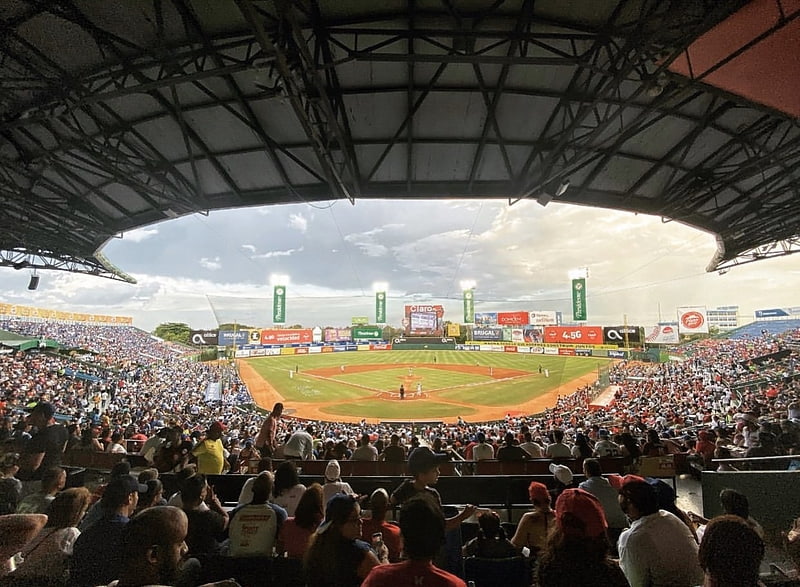
Stadium in Santo Domingo, Dominican Republic. Quisqueya Stadium Juan Marichal is a baseball stadium in Santo Domingo, Dominican Republic. It is often used as a multi-use stadium. Football club Atlético Pantoja used the venue for their inaugural Caribbean football championship match. The Quisqueya holds about 14,469 people after its renovation. The Dominican League of Baseball Authority is in charge of its management.
It is the only stadium in the Caribbean region to host two different baseball teams, Tigres del Licey (Licey Tigers) and Leones del Escogido (Chosen One Lions). Its field dimensions are 335 feet at the foul poles, 383 feet at the power alleys, and 411 feet at center field. It was built in 1955 as Estadio Trujillo, during the Rafael Leonidas Trujillo Molina dictatorship, taking the Bobby Maduro Miami Stadium as the design base.
The stadium was renamed Estadio Quisqueya Juan Marichal, after the former Major League Baseball player and Hall of Famer Juan Marichal.[2]
Address: Av. Tiradentes, 10511 Santo Domingo
Columbus Lighthouse
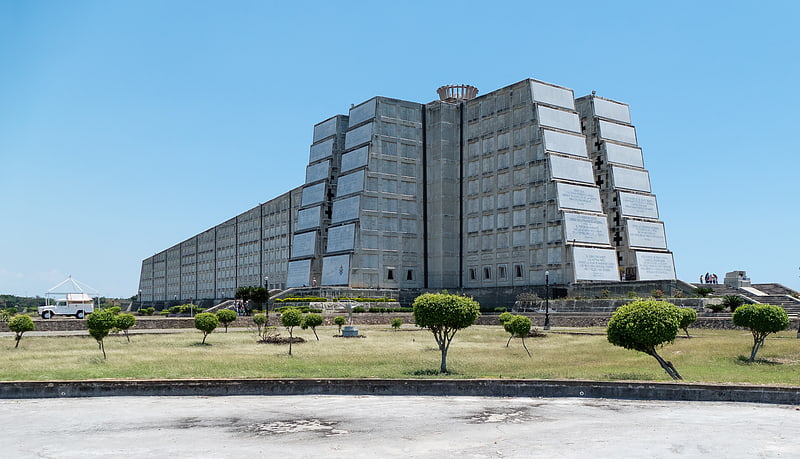
Also known as: Faro a Colón
Lighthouse monument to famous explorer. Columbus Lighthouse is a mausoleum monument located in Santo Domingo Este, Dominican Republic, in tribute to Christopher Columbus.
Construction began in 1986, using plans drawn by Scottish architect J.L. Gleave in 1931. In time for the 500th anniversary of Columbus's first voyage, the monument was inaugurated in 1992. It was funded by the Latin American states and the total cost of construction was approximately US$70 million.
The monument's lighthouse-style features projecting beams of light, forming a cross shape, which are so powerful that they can be seen from neighboring Puerto Rico.[3]
Address: Av. del Faro, 11604 Santo Domingo Este
Basilica Cathedral of Santa María la Menor
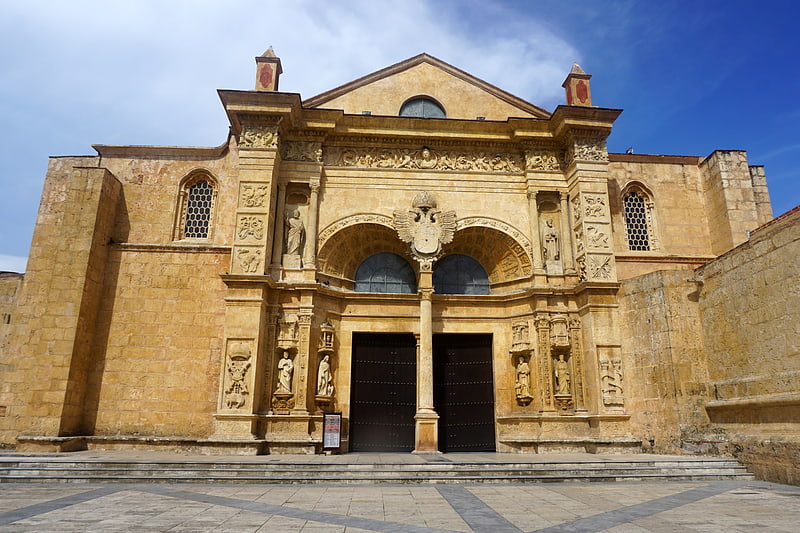
Also known as: Basílica catedral de Santa María de la Encarnación
Cathedral in Santo Domingo, Dominican Republic. The Cathedral of Santa María la Menor in the Colonial City of Santo Domingo is dedicated to St. Mary of the Incarnation. It is the first and oldest cathedral in the Americas, begun in 1504 and was completed in 1550. It is the Cathedral of the Archbishop of Santo Domingo who has the honorary title of Primate of the Indies because this cathedral was the first Catholic diocese and the oldest cathedral established in the New World.
The Cathedral is fronted with a golden-tinted coral limestone façade. The building is Gothic, a notable example of real Gothic architecture outside Europe. There is also a treasury which has an excellent art collection of ancient woodcarvings, furnishings, funerary monuments, silver, and jewelry.
It is located between Calle Arzobispo Merino and Isabel la Católica, next to Columbus Park in the city of Santo Domingo de Guzman.[4]
Address: Arzobisbo Meriño, 10210 Santo Domingo
Fortaleza Ozama

Riverside castle dating to 16th century. The Ozama Fortress, also formerly was known as the city wall's Homage tower. It is one of the surviving sections of the Walls of Santo domingo, which is recognized by UNESCO as being the oldest military construction of European origin in the Americas. It was built between 1502-1508 by the Spanish at the entrance to Santo Domingo's Ciudad Colonial, Dominican Republic, and overlooking the Ozama River. Named after this river, the castle, also referred to as "La Fortaleza" or "The Fortress". It was declared by UNESCO as a World Heritage Site, together with the other historical monuments of the Ciudad Colonial.
The Ozama Fortress is part of the Colonial City of Santo Domingo. According to historians and architects, the construction of this monument lasted from 1502 to 1508, which was started by Governor Nicolás Ovando. During the 16th century, the 18-meter high tower was the highest European-built construction of the Americas.
The construction of this fortress is designed in the form of a stone castle and still preserves its original architecture. Inside the fortress there are tunnels and dungeons where the prisoners were locked up, Christopher Columbus himself, one of the most important figures in the history of the Americas, was imprisoned in the Ozama fortress.[5]
Address: Calle de las Damas near Calle El Conde, Santo Domingo
Parque Colon
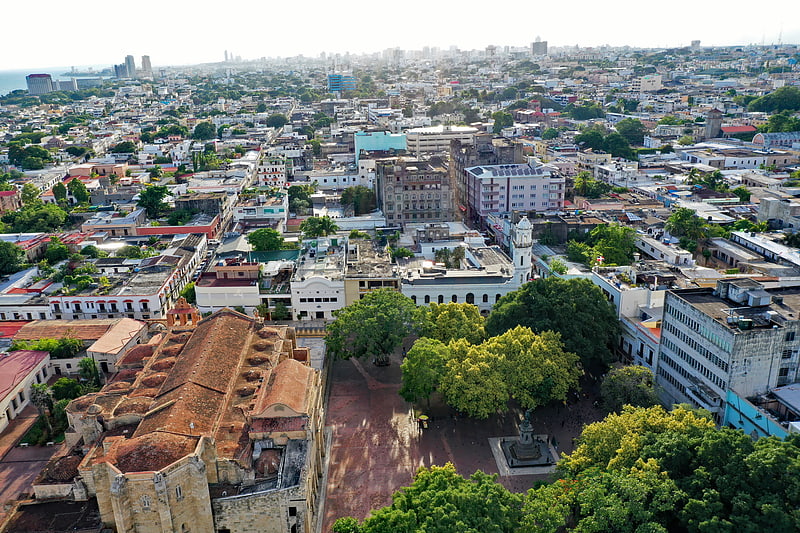
Also known as: Parque Colón
Historical landmark in Santo Domingo, Dominican Republic. Parque Colon, or Columbus Park, is the central square of the Ciudad Colonial historic district of Santo Domingo, Dominican Republic. In its Center stands a statue of Christopher Columbus, in whose honor the square was renamed in 1887. Previously the square was known as Plaza Mayor.
Monuments bordering the square include the Catedral de Santa Maria la Menor, Santo Domingo's Municipal Palace, and the Palacio Borgella, which once hosted the Dominican Republic's Parliament. Calle del Conde, once the thriving commercial heart of Santo Domingo, starts from Parque Colon and runs to the Puerta del Conde. At the beginning of Calle del Conde is a bust of Bartholomew Columbus, Christopher's brother and the founder of Santo Domingo.[6]
Address: C/ El Conde, 10210 Santo Domingo
National Palace

Also known as: Palacio Nacional
Building in Santo Domingo, Dominican Republic. The National Palace is a building in Santo Domingo, that houses the offices of the Executive Branch of the Dominican Republic.[7]
Address: Calle Moisés García, Santo Domingo
Memorial Museum of Dominican Resistance
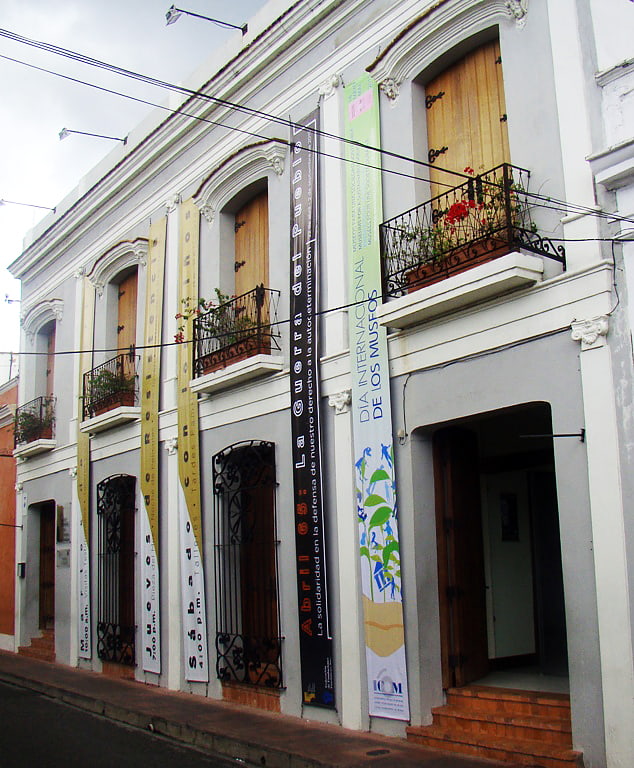
The Memorial Museum of Dominican Resistance is a museum dedicated to the preservation of the history regarding the struggles of several generations of Dominicans during the dictatorship of Rafael L. Trujillo, including its background and its consequences. On July 31, 2009, the museum's collection was declared part of the Memory of the World Programme by UNESCO, in order to protect its preservation and facilitate its access through this program.[8]
Address: Calle Arzobispo Nouel 210, 10210 Santo Domingo
Puerta del Conde
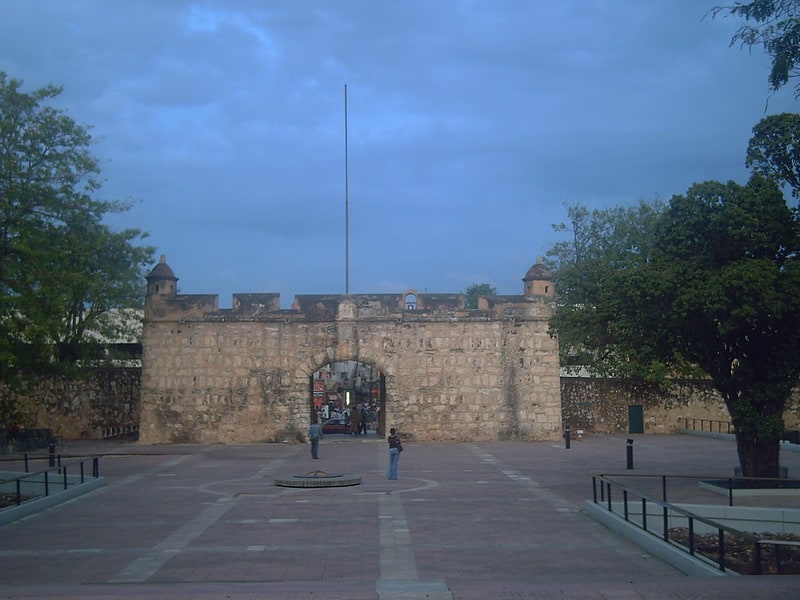
Also known as: Baluarte del Conde
Gate structure and Dominican heritage site. La Puerta del Conde was the main entrance to the fortified city of Santo Domingo, named to honor Governor Captain-General Bernardino de Meneses Bracamonte y Zapata, 1st Count of Peñalva, who during his tenure saved the city from a siege in 1655 by Englishmen General Robert Venables and Admiral William Penn amid the Third Anglo-Spanish War.
The gate is part of a structure called El Baluarte del Conde (The Count's Bulwark), a fort in Ciudad Colonial, the colonial area of Santo Domingo. The fort was part of a larger system of fortifications that ran along a defensive wall which surrounded Ciudad Colonial. The Altar of the Fatherland and Independence Park are located there.
Francisco del Rosario Sánchez, one of the Dominican Founding Fathers, proclaimed Dominican independence and raised the first Dominican Flag, on February 27, 1844.[9]
Address: Palo Hincado, 10210 Santo Domingo
Centro Israelita de República Dominicana
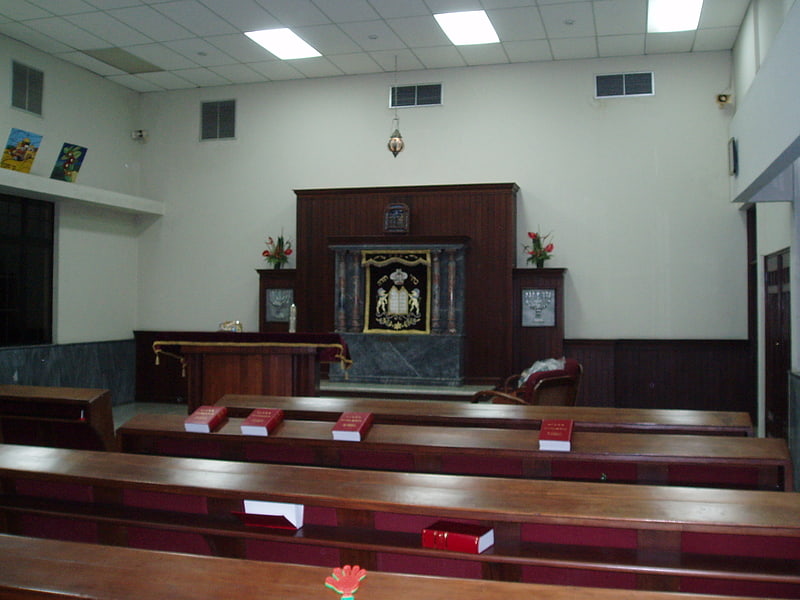
The Centro Israelita de República Dominicana is the main synagogue of the Jewish community in the Dominican Republic.[10]
Museo de las Casas Reales

Museum in Santo Domingo, Dominican Republic. The Museo de las Casas Reales is one of the important cultural monuments built during the colonial era in Hispaniola, now the Dominican Republic. It is located in the Colonial district of Santo Domingo.
It was the Palace of the Viceroy of Santo Domingo and it is the first (oldest) headquarters of Spanish power in the New World.
The building dates back to the sixteenth century, and was built to house the administrative offices of the Spanish colonies in the Americas, at the time any trespassers would be sentenced to death.
It is part of the UNESCO World Heritage Site called Colonial City of Santo Domingo.[11]
Address: Calle Las Damas, 10210 Santo Domingo
Botanical Garden

Also known as: Jardín Botánico
Botanical garden in Santo Domingo, Dominican Republic. Dr. Rafael Ma. Moscoso National Botanical Garden is a botanical garden in the heart of Santo Domingo. The park was founded in 1976 and was named after Rafael Maria Moscoso, a Dominican botanist who cataloged the flora on the island of Hispaniola.
The garden's symbol is a "guanito" leaf (Coccothrinax argentea) which is a palm tree found in the garden. The garden is a decentralized institution that reports to the Dominican Republic's Presidential Ministry of Management.[12]
Altar de la Patria
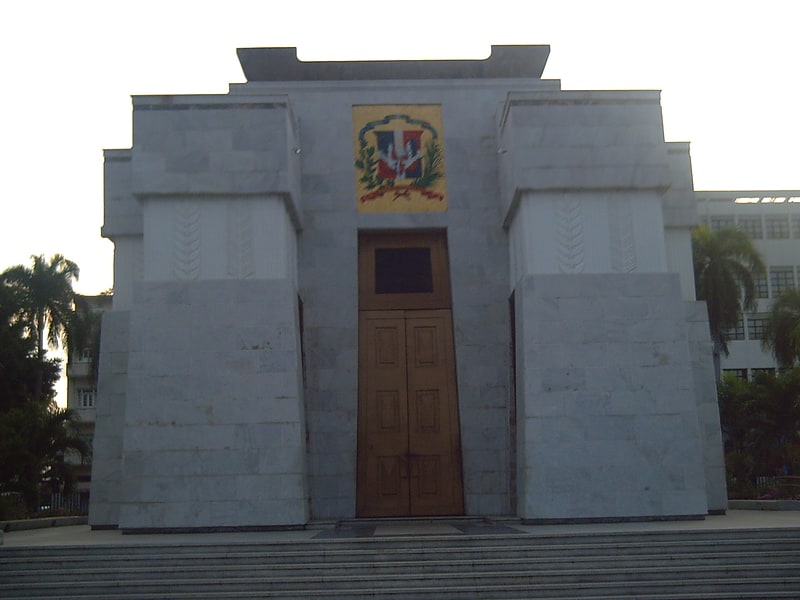
Museum in Santo Domingo, Dominican Republic. Altar de la Patria, or Altar of the Homeland, is a white marble mausoleum in Santo Domingo, Dominican Republic that houses the remains of the founding fathers of the Dominican Republic: Juan Pablo Duarte, Francisco del Rosario Sánchez, and Ramón Matías Mella, collectively known as Los Trinitarios. Within the mausoleum there are statues of the founding fathers, carved by Italian sculptor Nicholas Arrighini; there is as well an "eternal flame" that is kept lit in memory of the patriots. The Altar is within the Baluatre del Conde and is the main attraction of the Parque Independencia.[13]
Address: Av. Independencia, 10210 Santo Domingo
Reales Atarazanas
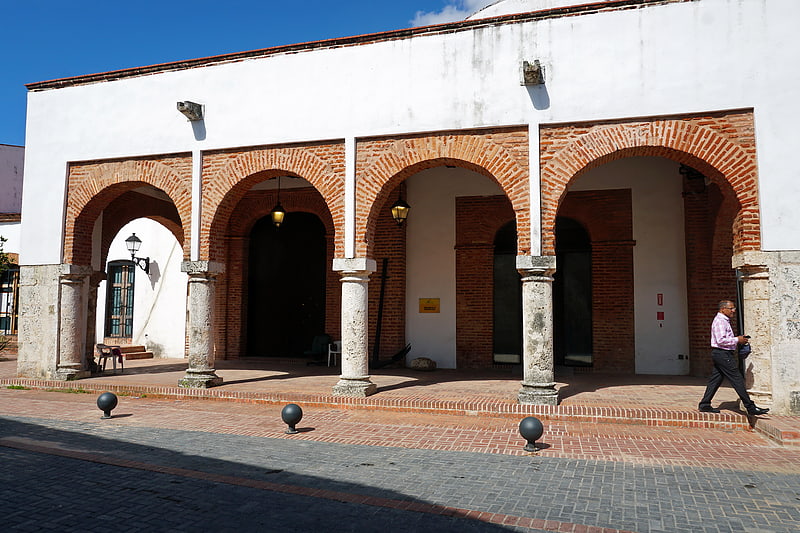
The Reales Atarazanas is a waterside building that housed the shipyards, warehouses, customs house and tax offices of the old port of Santo Domingo, Dominican Republic. It was the property of the Spanish Crown. Begun in 1509, the Atarazanas is the oldest building of its type still standing in America, and one of a handful remaining in the Spanish world, amongst which are the Atarazanas Reales de Barcelona, in Barcelona, the Atarazanas Reales de Sevilla, in Seville and the Atarazanas del Grao in Valencia.
The Atarazanas building is part of Colonial City of Santo Domingo World Heritage Site, and after full restoration in 2018, today houses the Museo de las Atarazanas Reales, which reopened in December 2019 and exhibits artifacts recovered from underwater archaeology and other artifacts from colonial shipwrecks around Hispaniola island and the naval history of the Dominican Republic.[14]
National Pantheon of the Dominican Republic
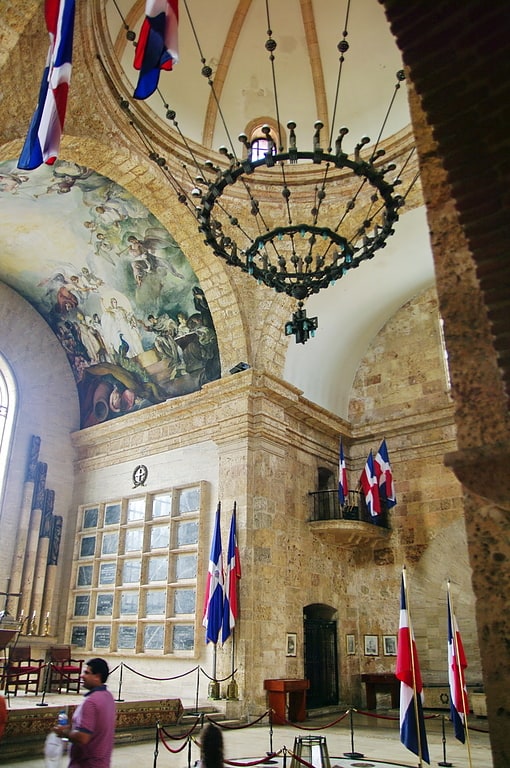
Also known as: Panteón de la Patria
Historical place in Santo Domingo, Dominican Republic. The National Pantheon was built from 1714 to 1746 by the Spaniard Geronimo Quezada y Garçon and was originally a Jesuit church. The structure was constructed in the neoclassic-renaissance style. Today, the structure stands as a national symbol of the Dominican Republic and serves as the final resting place of the Republic's most honored citizens.[15]
Address: Calle Las Damas, 10210 Santo Domingo